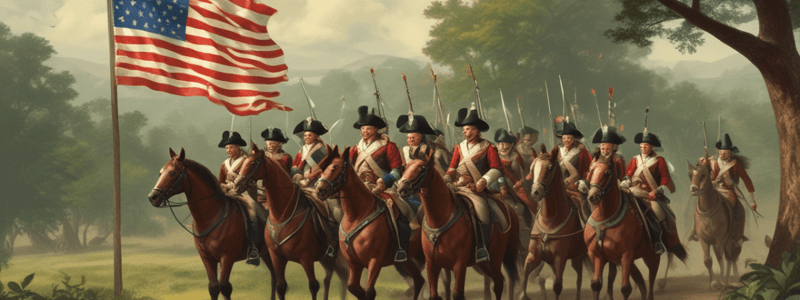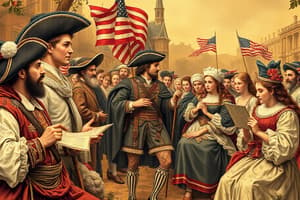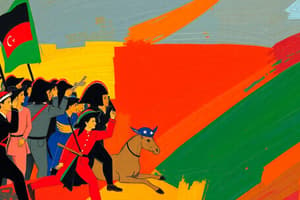Podcast
Questions and Answers
What was the primary reason for the settlement of the northern colonies?
What was the primary reason for the settlement of the northern colonies?
Seeking religious freedom
What was the significance of the Atlantic Ocean in the settlement of the colonies?
What was the significance of the Atlantic Ocean in the settlement of the colonies?
It played a crucial role
What was a common characteristic of the New England and Southern Colonies despite their different reasons for settlement?
What was a common characteristic of the New England and Southern Colonies despite their different reasons for settlement?
Increasing religious toleration and pluralism
What is an example of a push factor?
What is an example of a push factor?
What was the primary attraction of the British North American colonies for many settlers?
What was the primary attraction of the British North American colonies for many settlers?
What was the name of the group that founded Plymouth Colony in 1620?
What was the name of the group that founded Plymouth Colony in 1620?
What did the Puritans view their new world refuge as, and what did it symbolize?
What did the Puritans view their new world refuge as, and what did it symbolize?
What was the primary motivation for settlement in the Massachusetts Bay Colony?
What was the primary motivation for settlement in the Massachusetts Bay Colony?
What was the significance of shipbuilding, trading, and fishing in the New England colonies?
What was the significance of shipbuilding, trading, and fishing in the New England colonies?
What was unique about the Middle Colonies in terms of demographics?
What was unique about the Middle Colonies in terms of demographics?
What was the primary motivation for settlement in the Middle Colonies?
What was the primary motivation for settlement in the Middle Colonies?
What was the 'Breadbasket colonies' known for in the Middle Colonies?
What was the 'Breadbasket colonies' known for in the Middle Colonies?
What saved Jamestown from failing and led to the growth of the Virginia Colony?
What saved Jamestown from failing and led to the growth of the Virginia Colony?
What was the significance of the headright system in the Southern Colonies?
What was the significance of the headright system in the Southern Colonies?
What was the primary motivation for settlement in the Southern Colonies?
What was the primary motivation for settlement in the Southern Colonies?
What was the climate and geography like in the Southern Colonies?
What was the climate and geography like in the Southern Colonies?
Flashcards are hidden until you start studying
Study Notes
13 Original Colonies to War of 1812 (1607-1815)
The 3 Colonial Regions
- The 13 British colonies were divided into New England, Middle, and Southern colonies.
Push and Pull Factors
- Push factors: political or religious persecution, economic hardship, or natural or human-made disasters that cause people to leave their homeland.
- Pull factors: freedom, education, and job opportunities that attract people to a new country.
The New England Colonies
- Consisted of Rhode Island, New Hampshire, Massachusetts, and Connecticut.
- Founded by Puritans in 1620, who sought religious freedom.
- Plymouth Colony eventually merged with Massachusetts Bay Colony.
- Economy relied heavily on the Atlantic Ocean, with shipbuilding, trading, and fishing as primary activities.
- Slavery existed but was not the primary form of labor.
- Geography: long, cold winters, rocky and poor soil quality, and areas covered with white pine and oak trees.
- Government: self-government took form in town hall meetings where citizens gathered, discussed issues, and allowed men to vote.
The Middle Colonies
- Consisted of New York, Pennsylvania, New Jersey, and Delaware.
- Population was diverse, with many ethnicities, languages, and religions.
- Quakers, led by William Penn, practiced non-violence, women's rights, and religious tolerance.
- Huguenots, fleeing persecution in Catholic France, settled in New Netherland.
- Slavery was present but less popular due to the emphasis on equality.
- Economy was diverse, with a combination of farming and a coast for shipping.
- Inland waterways helped create a thriving fur trade with Native Americans.
- Geography: warm summers, cold winters, coastlines, rivers, good soil, and some mountains.
The Southern Colonies
- Consisted of Maryland, Virginia, North Carolina, South Carolina, and Georgia.
- Founded in 1607, with Jamestown as the first successful English settlement.
- Tobacco saved Jamestown from failing and led to the Virginia Colony's birth.
- The headright system was formed to entice settlers to Virginia.
- Staple crops (tobacco, rice, and indigo) gave birth to the plantation system.
- Slavery and indentured servants became the majority of laborers.
- Involuntary Migration: forced displacement of people from their home or region (slaves).
- Indentured servants agreed to work for a long period in exchange for a free voyage.
- Southern colonists were devoutly connected to Great Britain religiously (Anglican) and economically.
- Economy relied on the plantation system, with tobacco, rice, and indigo as cash crops.
- Geography: warm climate, fertile soil, and long rivers flowing to the Atlantic Ocean.
- Government: social class/headright system.
Mercantilism and Triangular Trade
- Mercantilism: providing natural resources and raw materials to the mother country, enriching the mother country's wealth.
- Triangular trade: a trade network involving three continents, with goods and commodities exchanged at high levels.
Studying That Suits You
Use AI to generate personalized quizzes and flashcards to suit your learning preferences.




